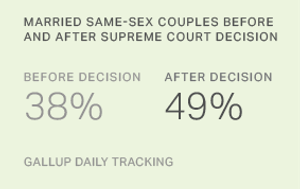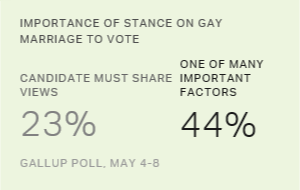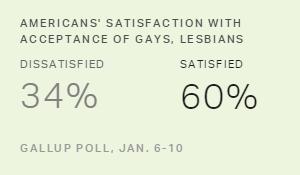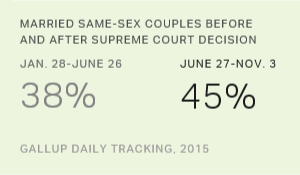Story Highlights
- Nearly half of cohabiting same-sex couples now married
- Up from 38% before same-sex marriage legalized in all states
- 9.6% of LGBT Americans married to same-sex spouse, up from 7.9%
PRINCETON, N.J. -- The proportion of same-sex cohabiting couples who are married has increased from 38% to 49% in the year since the U.S. Supreme Court legalized same-sex marriage nationwide.
| Pre-Obergefell v. Hodges decision | Post-Obergefell v. Hodges decision | ||||||||||||||||||||||||||||||||||||||||||||||||||||||||||||||||||||||||||||||||||||||||||||||||||
|---|---|---|---|---|---|---|---|---|---|---|---|---|---|---|---|---|---|---|---|---|---|---|---|---|---|---|---|---|---|---|---|---|---|---|---|---|---|---|---|---|---|---|---|---|---|---|---|---|---|---|---|---|---|---|---|---|---|---|---|---|---|---|---|---|---|---|---|---|---|---|---|---|---|---|---|---|---|---|---|---|---|---|---|---|---|---|---|---|---|---|---|---|---|---|---|---|---|---|---|
| % | % | ||||||||||||||||||||||||||||||||||||||||||||||||||||||||||||||||||||||||||||||||||||||||||||||||||
| Married | 38 | 49 | |||||||||||||||||||||||||||||||||||||||||||||||||||||||||||||||||||||||||||||||||||||||||||||||||
| Living together but not married | 62 | 51 | |||||||||||||||||||||||||||||||||||||||||||||||||||||||||||||||||||||||||||||||||||||||||||||||||
| Note: Since Jan. 28, 2015, Gallup has measured sex of spouse/partner for LGBT respondents reporting they are married or living with a partner. | |||||||||||||||||||||||||||||||||||||||||||||||||||||||||||||||||||||||||||||||||||||||||||||||||||
| Gallup Daily tracking | |||||||||||||||||||||||||||||||||||||||||||||||||||||||||||||||||||||||||||||||||||||||||||||||||||
On June 26, 2015, the Supreme Court in Obergefell v. Hodges struck down prohibitions on same-sex marriage in the 13 states that still had them. Since then, the same-sex marriage rate has grown significantly in those 13 states, but it has also grown in the states where it was already legal. The increase has been slightly greater (13 percentage points versus 10 points) in the states that had prohibited same-sex marriage before last June.
| Marital status | Pre-Obergefell v. Hodges decision | Post-Obergefell v. Hodges decision | ||||||||||||||||||||||||||||||||||||||||||||||||||||||||||||||||||||||||||||||||||||||||||||||||||
|---|---|---|---|---|---|---|---|---|---|---|---|---|---|---|---|---|---|---|---|---|---|---|---|---|---|---|---|---|---|---|---|---|---|---|---|---|---|---|---|---|---|---|---|---|---|---|---|---|---|---|---|---|---|---|---|---|---|---|---|---|---|---|---|---|---|---|---|---|---|---|---|---|---|---|---|---|---|---|---|---|---|---|---|---|---|---|---|---|---|---|---|---|---|---|---|---|---|---|---|---|
| % | % | |||||||||||||||||||||||||||||||||||||||||||||||||||||||||||||||||||||||||||||||||||||||||||||||||||
| Same-sex marriage NOT legal in state before June 26, 2015 | ||||||||||||||||||||||||||||||||||||||||||||||||||||||||||||||||||||||||||||||||||||||||||||||||||||
| Married | 26 | 39 | ||||||||||||||||||||||||||||||||||||||||||||||||||||||||||||||||||||||||||||||||||||||||||||||||||
| Living together but not married | 74 | 61 | ||||||||||||||||||||||||||||||||||||||||||||||||||||||||||||||||||||||||||||||||||||||||||||||||||
| Same-sex marriage legal in state before June 26, 2015 | ||||||||||||||||||||||||||||||||||||||||||||||||||||||||||||||||||||||||||||||||||||||||||||||||||||
| Married | 42 | 52 | ||||||||||||||||||||||||||||||||||||||||||||||||||||||||||||||||||||||||||||||||||||||||||||||||||
| Living together but not married | 58 | 48 | ||||||||||||||||||||||||||||||||||||||||||||||||||||||||||||||||||||||||||||||||||||||||||||||||||
| Note: Since Jan. 28, 2015, Gallup has measured sex of spouse/partner for LGBT respondents reporting they are married or living with a partner. | ||||||||||||||||||||||||||||||||||||||||||||||||||||||||||||||||||||||||||||||||||||||||||||||||||||
| Gallup Daily tracking | ||||||||||||||||||||||||||||||||||||||||||||||||||||||||||||||||||||||||||||||||||||||||||||||||||||
The proportion of married same-sex couples remains higher in states in which the practice had been legal before the Supreme Court's ruling -- 52% to 39%, with only a slight closing of the gap in the past year.
The results are based on Gallup Daily tracking interviews conducted throughout 2015 and 2016. Gallup asks U.S. adults if they identify as lesbian, gay, bisexual or transgender, and to indicate their marital status. Those who say they are LGBT and are either married or living in a domestic partnership are asked whether their spouse or partner is of the same sex or the opposite sex.
Gallup currently estimates 3.9% of U.S. adults are lesbian, gay, bisexual or transgender, and 0.4% of U.S. adults are married to a same-sex spouse. These figures can be used to estimate there are approximately 981,000 U.S. adults in a same-sex marriage and, thus, 491,000 same-sex marriages in the U.S. That latter estimate is up from roughly 368,000 a year ago.
One in 10 LGBT Adults Now Report Being Married to Same-Sex Spouse
Currently, 9.6% of LGBT adults report being married to a same-sex spouse, up from 7.9% before the landmark court decision. Meanwhile, the percentage of LGBT Americans who are living with a same-sex domestic partner has declined, from 12.8% to 10.1% -- a larger decline compared with the increase in same-sex marriages. This indicates that while many unmarried same-sex couples who were living together got married in the past year, many others stopped living together or no longer consider themselves to be domestic partners. The largest percentage of LGBT Americans -- 49.9% -- continue to identify as single or never married, up from 47.4% a year ago.
| Pre-Obergefell v. Hodges decision | Post-Obergefell v. Hodges decision | Change | |||||||||||||||||||||||||||||||||||||||||||||||||||||||||||||||||||||||||||||||||||||||||||||||||
|---|---|---|---|---|---|---|---|---|---|---|---|---|---|---|---|---|---|---|---|---|---|---|---|---|---|---|---|---|---|---|---|---|---|---|---|---|---|---|---|---|---|---|---|---|---|---|---|---|---|---|---|---|---|---|---|---|---|---|---|---|---|---|---|---|---|---|---|---|---|---|---|---|---|---|---|---|---|---|---|---|---|---|---|---|---|---|---|---|---|---|---|---|---|---|---|---|---|---|---|
| % | % | pct. pts. | |||||||||||||||||||||||||||||||||||||||||||||||||||||||||||||||||||||||||||||||||||||||||||||||||
| Married to same-sex spouse | 7.9 | 9.6 | +1.7 | ||||||||||||||||||||||||||||||||||||||||||||||||||||||||||||||||||||||||||||||||||||||||||||||||
| Living with same-sex partner | 12.8 | 10.1 | -2.7 | ||||||||||||||||||||||||||||||||||||||||||||||||||||||||||||||||||||||||||||||||||||||||||||||||
| Single/Never married | 47.4 | 49.9 | +2.5 | ||||||||||||||||||||||||||||||||||||||||||||||||||||||||||||||||||||||||||||||||||||||||||||||||
| Living with opposite-sex partner | 4.8 | 5 | +0.2 | ||||||||||||||||||||||||||||||||||||||||||||||||||||||||||||||||||||||||||||||||||||||||||||||||
| Married to opposite-sex spouse | 14.2 | 13.6 | -0.6 | ||||||||||||||||||||||||||||||||||||||||||||||||||||||||||||||||||||||||||||||||||||||||||||||||
| Divorced | 7.1 | 6.4 | -0.7 | ||||||||||||||||||||||||||||||||||||||||||||||||||||||||||||||||||||||||||||||||||||||||||||||||
| Separated | 2.5 | 2.2 | -0.3 | ||||||||||||||||||||||||||||||||||||||||||||||||||||||||||||||||||||||||||||||||||||||||||||||||
| Widowed | 2.8 | 2.9 | +0.1 | ||||||||||||||||||||||||||||||||||||||||||||||||||||||||||||||||||||||||||||||||||||||||||||||||
| Gallup Daily tracking | |||||||||||||||||||||||||||||||||||||||||||||||||||||||||||||||||||||||||||||||||||||||||||||||||||
At the time of Gallup's initial update on same-sex marriages after the Supreme Court ruling, 9.6% of LGBT Americans said they were married to a same-sex spouse. Since that November update, the percentage is essentially unchanged, at 9.5%. This suggests there was a burst of same-sex marriages in the first few months after the Supreme Court ruling but little additional increase since then.
Males who identify as LGBT are more likely than females who identify as LGBT to report being married to a same-sex spouse (10.5% vs. 8.8%, respectively). Gallup tracking documents similar increases since last June in the percentage of both groups who are in a same-sex marriage. A year ago, 8.7% of LGBT men and 7.2% of LGBT women said they were married to a same-sex spouse.
Implications
Gallup's data indicate a clear increase in same-sex marriages in the U.S. since the Supreme Court granted those unions legal status nationwide. Now, roughly half of all cohabiting same-sex couples are married, up from 38% a year ago. Gallup estimates that approximately 123,000 same-sex marriages have taken place since the Obergefell v. Hodges decision, with increases apparent among those living in states where same-sex marriage was already legal as well as those where it was not.
More recent data collected since Gallup's initial update on same-sex marriages in November show the growth in same-sex marriages may be leveling off. The Obergefell v. Hodges ruling appears to have provided the impetus for an initial surge in same-sex marriages, but that surge only lasted a short while. Going forward, as the nation moves further away in time from that June 2015 decision, increases in the same-sex marriage rate may be more evident in the long term rather than in the short term.
This is especially likely given that the U.S. LGBT population is decidedly young, and many who one day want to marry a same-sex spouse are not currently at a point in their lives when they are likely to seriously consider marriage.
These data are available in Gallup Analytics.
Survey Methods
Results for this Gallup poll are based on telephone interviews with a random sample of U.S. adults, aged 18 and older, living in all 50 U.S. states and the District of Columbia, on the Gallup U.S. Daily survey. Sample sizes and margins of error are shown in the accompanying table:
| Sample | Sample size | Margin of error | ||||||||||||||||||||||||||||||||||||||||||||||||||||||||||||||||||||||||||||||||||||||||||||||||||
|---|---|---|---|---|---|---|---|---|---|---|---|---|---|---|---|---|---|---|---|---|---|---|---|---|---|---|---|---|---|---|---|---|---|---|---|---|---|---|---|---|---|---|---|---|---|---|---|---|---|---|---|---|---|---|---|---|---|---|---|---|---|---|---|---|---|---|---|---|---|---|---|---|---|---|---|---|---|---|---|---|---|---|---|---|---|---|---|---|---|---|---|---|---|---|---|---|---|---|---|---|
| % | ||||||||||||||||||||||||||||||||||||||||||||||||||||||||||||||||||||||||||||||||||||||||||||||||||||
| Pre-Obergefell v. Hodges decision (Jan. 28-June 26, 2015) | ||||||||||||||||||||||||||||||||||||||||||||||||||||||||||||||||||||||||||||||||||||||||||||||||||||
| National adults | 148,457 | +/-1 | ||||||||||||||||||||||||||||||||||||||||||||||||||||||||||||||||||||||||||||||||||||||||||||||||||
| LGBT | 4,752 | +/-2 | ||||||||||||||||||||||||||||||||||||||||||||||||||||||||||||||||||||||||||||||||||||||||||||||||||
| Non-LGBT | 135,643 | +/-1 | ||||||||||||||||||||||||||||||||||||||||||||||||||||||||||||||||||||||||||||||||||||||||||||||||||
| Post-Obergefell v. Hodges decision (June 27, 2015-June 19, 2016) | ||||||||||||||||||||||||||||||||||||||||||||||||||||||||||||||||||||||||||||||||||||||||||||||||||||
| National adults | 351,880 | +/-1 | ||||||||||||||||||||||||||||||||||||||||||||||||||||||||||||||||||||||||||||||||||||||||||||||||||
| LGBT | 11,588 | +/-1 | ||||||||||||||||||||||||||||||||||||||||||||||||||||||||||||||||||||||||||||||||||||||||||||||||||
| Non-LGBT | 322,321 | +/-1 | ||||||||||||||||||||||||||||||||||||||||||||||||||||||||||||||||||||||||||||||||||||||||||||||||||
| Gallup Daily tracking | ||||||||||||||||||||||||||||||||||||||||||||||||||||||||||||||||||||||||||||||||||||||||||||||||||||
All reported margins of sampling error include computed design effects for weighting.
Each sample of national adults includes a minimum quota of 60% cellphone respondents and 40% landline respondents, with additional minimum quotas by time zone within region. Landline and cellular telephone numbers are selected using random-digit-dial methods.
Learn more about how Gallup Daily tracking works.




